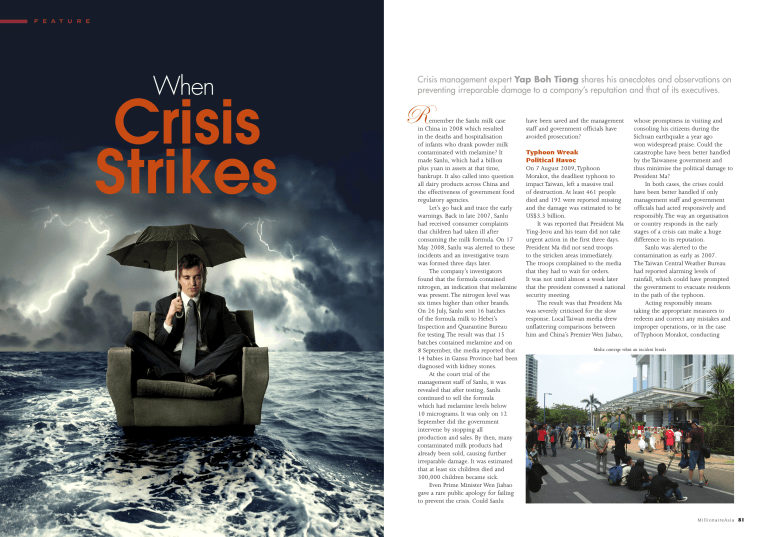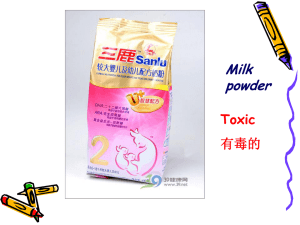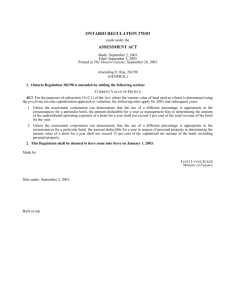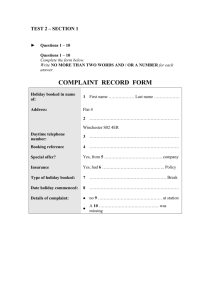Please click here to the high resolution article

F E A T U R E
When
Strikes
Crisis management expert Yap Boh Tiong shares his anecdotes and observations on preventing irreparable damage to a company’s reputation and that of its executives.
R emember the Sanlu milk case in China in 2008 which resulted in the deaths and hospitalisation of infants who drank powder milk contaminated with melamine? It made Sanlu, which had a billion plus yuan in assets at that time, bankrupt. It also called into question all dairy products across China and the effectiveness of government food regulatory agencies.
Let’s go back and trace the early warnings. Back in late 2007, Sanlu had received consumer complaints that children had taken ill after consuming the milk formula. On 17
May 2008, Sanlu was alerted to these incidents and an investigative team was formed three days later.
The company’s investigators found that the formula contained nitrogen, an indication that melamine was present. The nitrogen level was six times higher than other brands.
On 26 July, Sanlu sent 16 batches of the formula milk to Hebei’s
Inspection and Quarantine Bureau for testing. The result was that 15 batches contained melamine and on
8 September, the media reported that
14 babies in Gansu Province had been diagnosed with kidney stones.
At the court trial of the management staff of Sanlu, it was revealed that after testing, Sanlu continued to sell the formula which had melamine levels below
10 micrograms. It was only on 12
September did the government intervene by stopping all production and sales. By then, many contaminated milk products had already been sold, causing further irreparable damage. It was estimated that at least six children died and
300,000 children became sick.
Even Prime Minister Wen Jiabao gave a rare public apology for failing to prevent the crisis. Could Sanlu have been saved and the management staff and government officials have avoided prosecution?
Typhoon Wreak
Political Havoc
On 7 August 2009, Typhoon
Morakot, the deadliest typhoon to impact Taiwan, left a massive trail of destruction. At least 461 people died and 192 were reported missing and the damage was estimated to be
US$3.3 billion.
It was reported that President Ma
Ying-Jeou and his team did not take urgent action in the first three days.
President Ma did not send troops to the stricken areas immediately.
The troops complained to the media that they had to wait for orders.
It was not until almost a week later that the president convened a national security meeting.
The result was that President Ma was severely criticised for the slow response. Local Taiwan media drew unflattering comparisons between him and China’s Premier Wen Jiabao, whose promptness in visiting and consoling his citizens during the
Sichuan earthquake a year ago won widespread praise. Could the catastrophe have been better handled by the Taiwanese government and thus minimise the political damage to
President Ma?
In both cases, the crises could have been better handled if only management staff and government officials had acted responsively and responsibly. The way an organisation or country responds in the early stages of a crisis can make a huge difference to its reputation.
Sanlu was alerted to the contamination as early as 2007.
The Taiwan Central Weather Bureau had reported alarming levels of rainfall, which could have prompted the government to evacuate residents in the path of the typhoon.
Acting responsibly means taking the appropriate measures to redeem and correct any mistakes and improper operations, or in the case of Typhoon Morakot, conducting
Media converge when an incident breaks
MillionaireAsia 81
F E A T U R E immediate evacuation and rescue operations for the affected citizens.
Sanlu, on the other hand, should have pulled off all its stocks from the shelves pending its own investigation. That would have been the most responsible thing to do.
A Crisis Closer To Home
Back in mid-2002, I received a call from a friend to help his relative, the founder of Health Biz, manage a looming crisis regarding the weight-reducing pills, Slim 10.
Health Biz was enjoying good sales until the pills were connected to the death of a consumer and the liver failure of a Singaporean celebrity.
The Slim 10 pills had worked effectively for the founder – having reduced his weight drastically. So when the crisis broke, he was in
China trying to find the answer from the Chinese manufacturer as to what had gone wrong with the pills.
Because he remained uncontactable, negative publicity proliferated. The authority was pressing charges and it was a week before the court hearing that I was asked to manage his crisis. The founder faced eight counts for contravening the Poisons Act which carried a maximum fine of $10,000 each and a jail term of two years for each of the eight charges.
While Health Biz had acted responsibly by withdrawing all the pills from the shelves after being directed by the regulatory body, the founder had not acted responsively to the public, the consumers and the media who all wanted an explanation.
My consultancy took a quick brief and prepared the founder to face the media. “Tell the truth” was our advice. He had consumed the pills and they had worked very well for him.
His weight dropped from 165 to 69 kilograms. For good measure, we told him to dangle his old baggy jeans in the journalists’ presence to press home the point.
He had trusted the manufacturer.
As the pills had been delivered straight to the packaging company in
Singapore, this ruled out the possibility that an external party had tampered with the pills. The authorities claimed that the pills were adulterated after they were tested for sale in Singapore.
The interviews with the media went very well. Negative perception of the founder turned to sympathy for a man whom they said was a “victim of circumstances”. In the final outcome, the founder was spared a jail sentence.
Instead, Health Biz was fined $45,000 for breach of licence.
A row of cars damaged by the bomb blast outside Marriott Islamabad
82 MillionaireAsia
Managing A Hotel Bombing
Finally, as an example of good practice in crisis management, I was called to assist the management in the
Marriott Islamabad hotel bombing last September. In that incident, a dump truck with more than 60kg of explosives detonated at the security check point at the main entrance of the hotel. Most of the people killed were locals including employees of the hotel.
Reputation damage was minimised as the hotel management acted both responsively and responsibly. First, communication was up on the Marriott website to inform relatives and guests to call a hotline for information and updates. The injured were quickly sent to local hospitals.
Secondly, in addition to taking care of the medical expenses, the
Pakistani hotel owner had announced within days of the incident that the hotel would continue to pay the wages of all its staff. Demonstrating care and concern for the hotel’s guests and employees was clearly evident here.
Working Towards
Preparedness
Most crises cause an organisation to come under intense scrutiny for the first few days. The media storm will taper, however, if properly managed.
The best remedy is of course, to observe the age-old Boy Scouts’ motto
“Be Prepared”, that is, to get ready even before a crisis hits.
Organisations that are better equipped to handle crises are those that have in place a crisis plan, conduct scenario-based drills, media train their spokespersons and have in place prepared key messages and holding statements for immediate use. A crisis handled badly can cause irreparable damage to a corporation’s reputation, its products and services, and even the downfall of the company and its executives.
In this age of instant communications where a crisis can be reported within minutes of it happening by citizen journalists, the need to be better prepared is now more critical than ever.
ABouT YAP BoH Tiong
Yap Boh Tiong is the
Managing Director of Mileage
Communications, which is
Singapore’s biggest homegrown public relations consultancy with nine offices in six countries. Besides offering strategic counsel to many bluechip clients, the consultancy is the leading player in crisis management. It has handled more than 50 crises including many high profile ones such as the Raffles Town Club saga,
Nicoll Highway Collapse, AIA critical year option, hotel bombings, ship collisions and piracy on the high seas.
Every Crisis Is Different.
Yap shares the standard guidelines to observe in the first 48 hours of a disaster.
Assess the situation
– quickly gather the facts about the incident.
Activate the crisis management team
(the key personnel required to be in a crisis response room).
Mobilise your communications team
to handle the deluge of media enquiries and stakeholders’ responses, including online and traditional media platforms.
Take charge of the incident.
Draft a media response statement and after the necessary verification and confirmation of facts, issue it.
Inform employees and stakeholders.
Identify spokesperson for engagement with media. Put a statement on the corporate website and activate helplines.
Monitor media coverage, the public response and the evolving crisis.
Crisis response team holds regular updates to decide on appropriate responses to all stakeholders, especially the media.
Demonstrate sympathy, care and concern
for all involved, especially the affected parties.
Do not speculate
on the cause of the incident or attribute blame.
Rely only on facts.
Keep monitoring
outcome and responses from stakeholders. Give regular updates and respond appropriately by taking responsible measures and actions.
MillionaireAsia 83





